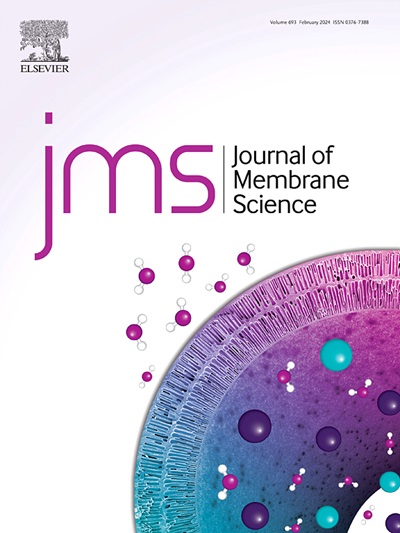Tuning properties of PEO-functionalized ion-solvating blend membranes via PEO side chain length: Impact on alkaline water electrolysis performance
IF 8.4
1区 工程技术
Q1 ENGINEERING, CHEMICAL
引用次数: 0
Abstract
Ion-solvating membranes (ISMs) based on chemical stable polyoxindole copolymers bearing long side PEO groups (MW750) were synthesized via a PEO-functionalization monomer strategy followed by super acid polyhydroxyalkylation. The synthesized copolymer membranes displayed very high electrolyte uptakes even at low KOH concentrations (10 wt%) due to deprotonation of oxindole groups enabling high KOH absorption. However, the increased plasticization resulted in deterioration of mechanical strength and the copolymers were therefore blended with m-PBI to yield mechanical robust, nanophase separated ISMs. Their physicochemical properties were tuned by adjusting the blend composition. The prepared blend membranes showed high KOH and water absorption in 30 wt% KOH concentration even higher than that of pure m-PBI. The presence of long hydrophilic side PEO chains facilitates both KOH and water uptake due to increased free volume and induced phase separation. This in turn resulted in high ionic conductivity exceeding 100 mS cm−1 at 80 °C. Long term stability in 30 wt% KOH at 80 °C for blend PBI80/P(IB-PEO750) was excellent: the conductivity remained unchanged (at room temperature), the thermal stability was improved, while the membrane retained its flexibility and the tensile strength and Young's modulus remained high after the 2 months (1440 h) test. The excellent alkaline stability was attributed to the stabilization of blend membranes via strong attractive electrostatic interactions between m-PBI's imidazolide and isatin or PEO groups with K+. The blend PBI80/P(IB-PEO750) was evaluated under alkaline electrolysis conditions using a 30 wt% KOH feed solution at 80 °C. It exhibited a high current density of 1.06 A cm−2 at 1.8 V. In comparison, the corresponding blend with short PEO groups PBI80/P(IB-PEO350) showed higher current density of 1.36 A cm−2 at the same voltage, which is comparable to the excellent performance of m-PBI. Long-term durability tests revealed that the cell with PBI80/P(IB-PEO750) membrane successfully run for 250 h at 80 °C under a constant current density of 0.5 A cm−2, in contrast to the cell with PBI80/P(IB-PEO350) membrane, which failed after 160 h, showing its applicability in harsh alkaline AWE conditions. In addition, the H2 in O2 content for both cells with different blend membranes was low, in the range of 1.4–1.65 vol%, indicating low gas impurities for both cells. This work provides a simple blending strategy for designing chemically stable, with promising performance membranes for alkaline water electrolysis.

PEO侧链长度对PEO功能化离子溶剂化共混膜性能的影响
采用PEO官能化单体和超强酸多羟基烷基化法制备了具有化学稳定性的长侧PEO聚氧吲哚共聚物(MW750)离子溶剂化膜。合成的共聚物膜即使在低KOH浓度(10 wt%)下也显示出非常高的电解质吸收,这是由于氧吲哚基团的去质子化使得高KOH吸收。然而,增加的塑化导致机械强度下降,因此共聚物与m-PBI共混,以产生机械坚固的纳米相分离ISMs。通过调整共混物的组成来调整其理化性质。制备的共混膜在30 wt%的KOH浓度下具有较高的KOH和吸水率,甚至高于纯m-PBI。由于增加了自由体积和诱导相分离,长亲水性侧PEO链的存在促进了KOH和水的吸收。这反过来又导致高离子电导率超过100 mS cm−1在80°C。共混PBI80/P(IB-PEO750)在30 wt% KOH和80°C下的长期稳定性非常好:电导率保持不变(室温),热稳定性得到改善,而膜在2个月(1440小时)测试后仍保持其柔韧性,拉伸强度和杨氏模量保持较高。由于m-PBI的咪唑烷与isatin或PEO基团与K+之间的强吸引静电相互作用,共混膜具有良好的碱性稳定性。混合PBI80/P(IB-PEO750)在碱性电解条件下,使用30 wt% KOH进料溶液,在80°C下进行评估。在1.8 V电压下,其电流密度高达1.06 a cm−2。相比之下,与短PEO基团PBI80/P相对应的共混物(IB-PEO350)在相同电压下的电流密度更高,为1.36 A cm−2,与m-PBI的优异性能相当。长期耐久性测试表明,PBI80/P(IB-PEO750)膜的电池在80°C、0.5 a cm−2的恒定电流密度下成功运行250 h,而PBI80/P(IB-PEO350)膜的电池在160 h后失效,表明其适用于恶劣的碱性AWE条件。此外,两种混合膜电池的O2中H2含量均较低,在1.4 ~ 1.65 vol%范围内,表明两种电池的气体杂质含量均较低。这项工作为设计化学稳定、性能良好的碱性电解膜提供了一种简单的混合策略。
本文章由计算机程序翻译,如有差异,请以英文原文为准。
求助全文
约1分钟内获得全文
求助全文
来源期刊

Journal of Membrane Science
工程技术-高分子科学
CiteScore
17.10
自引率
17.90%
发文量
1031
审稿时长
2.5 months
期刊介绍:
The Journal of Membrane Science is a publication that focuses on membrane systems and is aimed at academic and industrial chemists, chemical engineers, materials scientists, and membranologists. It publishes original research and reviews on various aspects of membrane transport, membrane formation/structure, fouling, module/process design, and processes/applications. The journal primarily focuses on the structure, function, and performance of non-biological membranes but also includes papers that relate to biological membranes. The Journal of Membrane Science publishes Full Text Papers, State-of-the-Art Reviews, Letters to the Editor, and Perspectives.
 求助内容:
求助内容: 应助结果提醒方式:
应助结果提醒方式:


